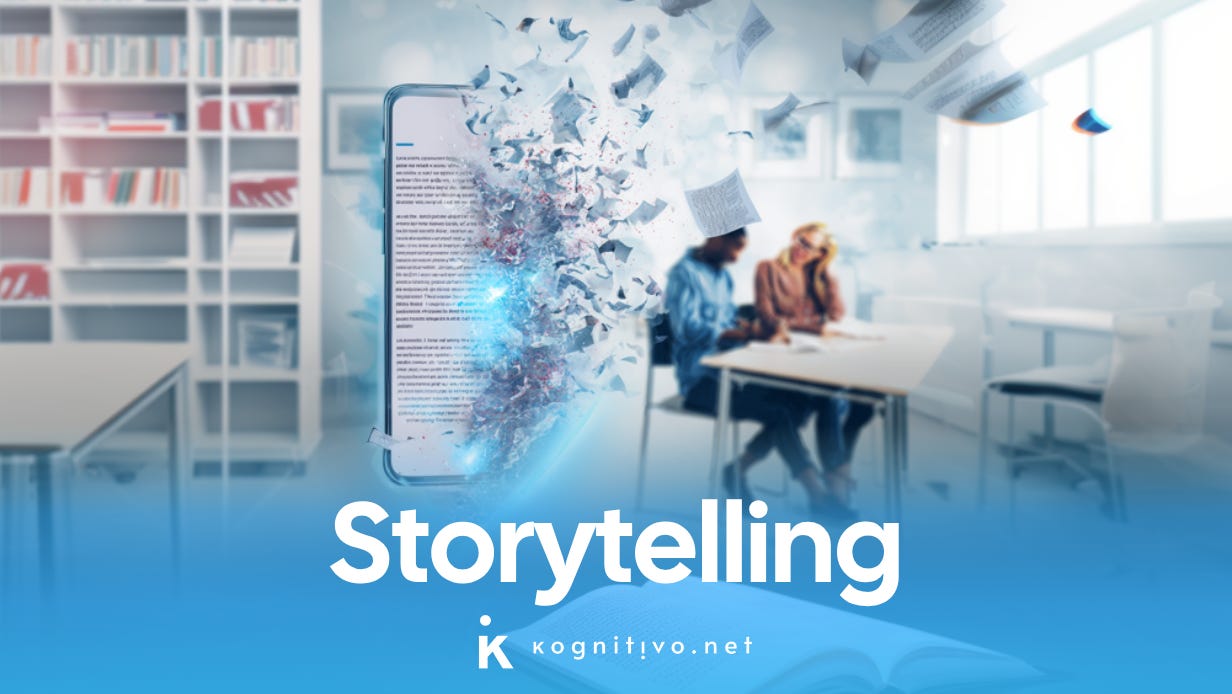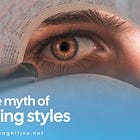The cognitive science of storytelling
We remember stories better than bullets. But are characters and drama really needed to learn better? A guide to storytelling in education that keeps the focus on outcomes.
Why can we recall the plot of a forgettable Netflix series from 2012, yet blank on last month’s compliance training? That’s not a memory flaw, that’s poor design.
Ten thousand years ago, humans gathered by a fire, learning to survive through stories. Today we sit by different fires: screens, classrooms, books. The medium changes, the technique doesn’t. Stories aren’t just entertainment, they’re memory technology.
What do we mean by storytelling?
In instructional design and teaching, storytelling means using narrative structure, setting or characters to help learners build a coherent mental model of the learning content. That coherence is the cognitive scaffold that makes information stick.
Storytelling is a powerful way to convey the relevance of a learning topic. It answers the learner’s question: why should I care? It helps learners understand why a concept or learning outcome matters, what it means in practice and how mastering it can be useful in real life. Storytelling highlights or creates a need, a sense of urgency for learning that the learning material (explanations, exercises, etc.) addresses.
The mechanism most often studied is narrative transportation. When people feel absorbed in a story, attention, emotion and imagery line up and memory improves. That’s why the same facts wrapped in a narrative are easier to recall and apply.
How much better do we learn with stories?
The idea that stories supercharge memory is hardly an undiscovered truth. But how much? Marketing blogs and LLMs often cite psychologist Jerome Bruner as saying that facts told as a story are remembered up to 22 times better. Well, that’s internet folklore: Jerome Bruner never said that!
However, a made-up exaggeration doesn’t disqualify the underlying reality. The real data is still striking: when learners wove items into a story, their long-term serial recall was about 93% vs 13% for rote study, roughly 6-7× better.
Is 10-12× ever realistic? Depending on the baseline and the task, some storytelling or story-based formats produce higher gains, but effects aren’t constant. Treat the headline number as a direction, not a law.
But why the advantage? Stories reduce cognitive load. They create cause-and-effect links, inferences that are easier to recall than isolated facts. They hold attention, evoke emotion, and promote transfer. Recent studies keep finding the same thing: when the story structure fits the goal, outcomes rise.
What counts as a story?
When we think of “stories” we often picture a character arc, like a hero’s journey. But character-driven plots aren’t the only kind of story, and in education they’re often overkill. Here are kinds of stories that work in education:
Linear stories. A simple beginning–middle–end is great when learners need coherence more than control. Typically, there’s a challenge or twist in the middle that’s resolved at the end. Explanations and exercises usually fit between middle and end.
Setting-based storytelling. Rather than a hero, a situation is the anchor. The setting makes the learner feel the need to learn something that the material (explanations, exercises) conveniently fulfills.
Setting-based storytelling can be further divided into different categories depending on the kind of arrangement.
Branching stories. Learners face decisions that shape the path: if you choose A, you go to scenario 2; if you choose B, you go to scenario 3. This is useful for judgment and “it depends” skills, and it aligns with simulation and situated learning research.
Case-based stories. Real or fictional cases for analysis are strongly supported in health and professional education, showing gains in problem solving and communication.
Problem or mystery structures. Start with a puzzle, reveal clues and drive to an explanation. Problem-based learning meta-analyses report gains in critical thinking versus lecture, especially for complex domains. The learning content (the skill to be learned) should be the key to solving the problem.
Transmedia arcs. Spread the story across formats, from short video to chat simulations. Transportation theory predicts higher absorption when imagery and coherence are well designed.
Summary: Linear stories work best for coherence, branching for judgment, cases for professional practice, mysteries for critical thinking and transmedia to create immersion.
How much storytelling is too much?
I have worked extensively with teachers, content writers, materials developers and instructional designers, and one thing is clear: education professionals love storytelling. As creative experts crafting learning experiences, they typically invest themselves quite intensely in the stories they build. But this can be counterproductive.
Story can help or hurt. The seductive details effect shows that interesting but irrelevant flourishes lower learning outcomes. Two meta-analyses (2020, 2012) and newer replications find small-to-moderate negative effects when details don’t serve the goal. The bottom line: trim the fluff.
Do we need characters?
One common myth is that every story needs characters. Not always. Characters can boost empathy, but they often add noise. A bare situation is often enough. The real test is: are characters necessary for the outcome?
Storytelling and character building are not the goals of a learning module. Learning is. Storytelling and characters are only useful if they help learners get there.
In some cases, they are necessary. Medical training, for example, requires people because the learning outcomes are about treating people. Consider: “Two patients arrive at the doctor’s with fever and cough. They suspect covid.” Clear, simple, on target. Adding names might help distinguish them, but that’s all we need.
On the other hand, consider: “Miguel and Oliver, lifelong friends who party hard, wake up sick after a late night…” That background is wasted space. It adds nothing to the learning goal.
Guideline:
Use characters only if the outcome requires them.
Add background only if it serves the goal.
If generic, use “you” as the protagonist (“Imagine you…”)
A common universe across modules
There is little research on using a common world or universe across modules. This is popular in language learning books (but not only) with recurring characters, settings and locations. In theory, this reduces cognitive load.
In practice, many learners skip modules and miss parts of the world. Topics often don’t fit naturally either. Writers often end up bending learning goals and content to match the story instead of the other way around. While a consistent world can help with branding and emotional connection, it also risks seductive details. Often, the effort isn’t worth it, but at the end of the day, it’s a matter of weighing pros and cons.
Clarity and immediate graspability of each storytelling scenario is the non‑negotiable principle, with or without a common storytelling universe across modules. This ensures the cognitive scaffold is in place without overburdening the design.
More practical tips for your stories
On top of the tricky topics of characters and world-building, here are some tips on how to keep your storytelling efficient and spot on:
1) Wrap micro-tasks in micro-stories.
Swap sterile prompts for tiny incidents. Instead of “Translate this sentence,” try “Your friend texts this. How do you reply?” It cues prior knowledge and invites inference.
2) Use branching for judgment, not procedures.
Branching shines where choices are ambiguous and feedback can show shades of gray. For step-by-step procedures, branching is overkill. Tie decisions to consequences learners can feel. Pair with short debriefs to surface the rule, ensuring the correct information sticks.
3) Start with a mystery, end with a payoff.
Open with a question or anomaly, then resolve it. Mystery structures sustain attention and give you a natural knowledge check at the reveal.
4) When stakes are high, simulate.
For complex skills, use narrative simulations. The evidence base for simulation-based learning is unusually strong. Even short scenario videos with branches show gains in applied knowledge.
5) Invite learners to tell the story.
Have learners generate brief narratives of a solution or error they encountered. Generation plus narrative chaining boosts recall and transfer.
The principle for storytelling in education is simple: every element must serve the learning outcome. If a detail, character, scene or even a sentence doesn’t support advancing the outcome, it’s a distraction and better left out. Research on seductive details is clear.
Not all storytelling is focused on learning
By now we know that storytelling and learning don’t always go hand in hand. A famous example comes from Homer’s Iliad. In Book 20, Homer describes in unexpected detail how Aeneas’ spear cuts through Achilles’ shield’s many layers of metal (cuts through bronze, stops at a layer of gold). For centuries, scholars assumed Homer provided a technical description of shield construction. More recent scholarship shows the design would make the shield useless in battle. The point was never metallurgy but symbolism.
This is a reminder for education: not all storytelling is focused on learning. A beautiful story can carry symbols, emotion and cultural significance without teaching a skill. Instructional storytelling has a narrower brief: it should support outcomes without weighing the learner down.
Learning time is story time… with a “but”
Storytelling isn’t window dressing. It shapes what learners notice, feel and remember.
Design the narrative to fit the goal, keep details coherent and right-size the arc for your audience. When you do, stories do what bullet points can’t. If you want learners to remember, give them a story worth retelling.
Or in one line: good stories teach because they serve the learning, not themselves.
Keep learning
Prompt suggestions. Always ask follow-up questions:
I want to design a short lesson using storytelling. Can you help me decide whether I should use a linear story, a branching scenario, or a case study for my topic?
Stories stick, but seductive details don’t. Can you give me examples of how to trim distracting background info from a learning story while keeping it engaging?
Act as a teacher and test me using retrieval practice on “storytelling in education.” Ask me 6 questions, one at a time, only continuing when I answer. Make them progressively harder.
Links
There are plenty of online resources on storytelling and teaching that provide tips on how to craft stories. Often, these resources don’t consider whether the advice is excessive, which it usually is. I have two recommendations: a tool to help you efficiently build great stories and research on the seductive detail effect to help you keep your stories on track.
Storyteller Tactics: Pipdecks produces decks of cards with tactics for tackling specific issues, such as productivity, team management and… storytelling! Each card provides a tactic to help you develop a narrative, such as “Downfall” or “The Dragon and the City.” These tactics are structures that can be applied in multiple settings. Sadly, they’re not available for free, but I wholeheartedly recommend them.
Seductive details hamper learning even when they do not disrupt: If you’re going to read one thing after this article, let it be this paper on the empirical findings related to how seductive details are detrimental to learning. I found other meta-analyses on the topic, but they’re sadly behind paywalls.






Thank you. I have been deep diving into his idea whilst designing a new curriculum with a narrative drive built in to enhance schema building. Using the idea of a story to build a sense of cultural capital is very powerful and, as an English literature teacher, it packs a double punch - enhanced engagement and retention combined with understanding the deep charge elements of a good plot. Thanks for the detailed overview.
This is so interesting! We’ve been using stories to anchor our science concepts and so far, students have always said that the lessons they remember the most are the ones with stories. Our focus is to humanize science but also to provide a context for the discoveries themselves.
I’ve also been reading up a lot on the science of learning and this is the first article Ive seen that mentions them both. I love the short discussion on why storytelling is effective and I’m excited to read more! Do you have any more articles or resources? Thank you!